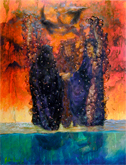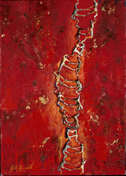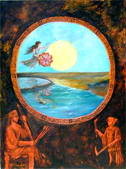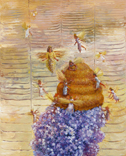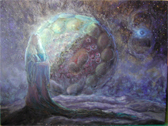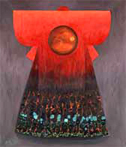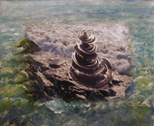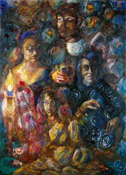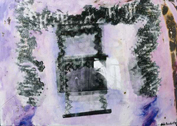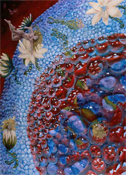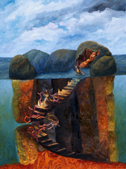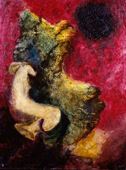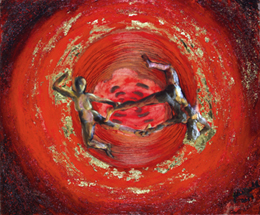
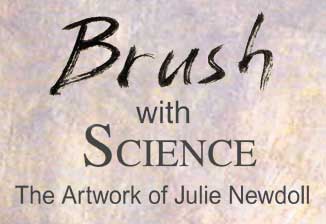
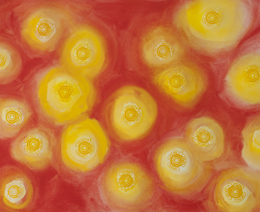
...Julie Newdoll merges life science and culture, myths and molecules in her
paintings, music, journal covers and science games.
Shakespeare:
A Mirror up to Science
![]()
See the recent article if you have access to JStor.
Interdisciplinary Literary Studies
published by Penn State University Press.
Hamlet, Art, and Apoptosis: The Shakespearean Artwork of Julie Newdoll
Marcia Eppich-Harris
Interdisciplinary Literary Studies
Vol. 17, No. 4 (2015), pp. 540-558
To see larger versions, click here, and for a history click here:
Cells must sometimes accept death for the good of the organism, and one means of accomplishing this task is via a pre-programmed system that exists in our cells called Apoptosis. In this series, the decision tree that Hamlet follows is compared with the steps a cell must make when faced with an order from the body to self-destruct.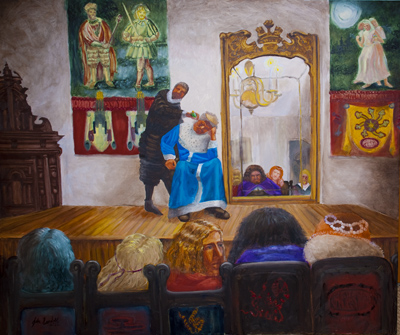
In the first painting in the series, "The Arrival of the Death Message" above, Hamlet has received his order from his father's ghost to avenge his death. Three friends are framed in a cellular membrane, with receptors for the death message protruding into the picture.
In the second painting, "The Mousetrap", Hamlet is testing to see whether his Uncle really did murder his father, much like a cell runs many self-checks before commiting to self destruction. What if, after all, the death message was a mistake, or the cause of the message has passed?
The third painting in the series, "The Commitment", is a key moment in the play, according to Marcia Eppich-Harris, Ph.D., the collaborating consultant for this series. Both the cell and Hamlet have made a commitment to kill, from which they will not turn back. It will, however, take time to follow through with their plans.
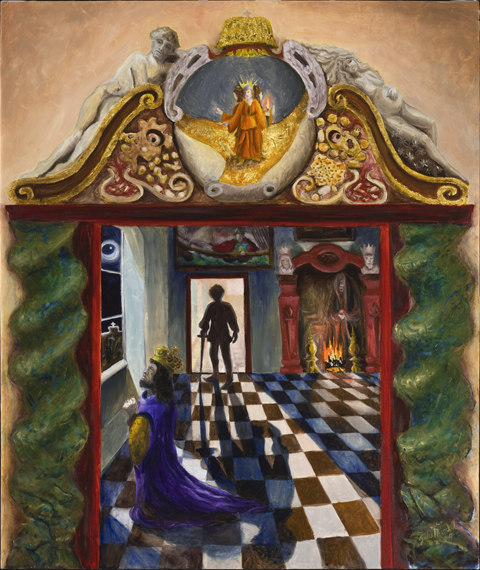
In Ophelia's Funeral, we have that absurd moment in the play where everything seems to be breaking down - all have hit bottom in Ophelia's grave. Hands reach in to "pluck them asunder". So too, in the cell, do fibrils form that pull pieces of the cell apart, organizing them into their final recyclable packets sometimes referred to as "coffins". In the dirt around the grave, we have a worm's eye view of a cell breaking down in a manner called "blebbing", where little round vesicles form from a once intact cell.

The final painting, "After the Dead March", has many references to the science in the play. Thoughts about the idea that the earth might orbit around the sun, and not vice versa; the Danish Court Astronomer of the day, Tycho Brahe, who's cousins had the names Knud Gyldenstierne and Frederick Rosenkrantz, the star in the sky which may be referred to in the beginning of the play, and could have been the supernova which appeared in the sky when Shakespeare was a boy, for example.
Aprogram of apoptosisis switched on when death of the cell is necessary for the fulfillment of a larger purpose. Hamlet may have chosen such a path.
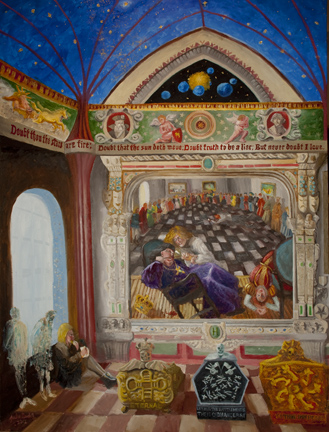
Cells often die during a person's life, such as in developmental stages. For instance, we all have webbed fingers in the womb and eventually the tissue between the fingers must be eliminated. When it is time for a cell to die, it gets a signal in the form of a small molecule that attaches to the outside of the cell. The cell does not die right away, however. The process begins, but checks are done to assure that destruction is necessary. At some point, the cell must "commit" to destruction. Via a built-in genetic program called Apoptosis, the DNA starts to be destroyed – chopped up - by cellular enzymes. Holes are punched in the mitochondria, the energy making organelles in the cell, "popping" them. The nucleus begins to degrade – into a crescent shape at first – and the cell starts turning into spherical packets of cellular debris.
For the full story, buy the book, coming soon!
Programmed
Cell Death:
Apoptosis
